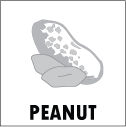
Peanut (a legume)
- About 3% of Americans suffer from peanut allergy.
- Considered a common allergen, and likely increasing in prevalence.
- Starts early in life, between 6 to 24 months of age.
- Only 15% of people develop tolerance over their lifetime.
Relevance to Food Service
- Be able to identify food or drink that is served or sold that contain Peanut protein.
- Awareness that peanuts can readily cross-react with any other legume, such green peas or Red Kidney beans.
- Care in preparation and service is critical to prevent cross-contact between the allergen-free food and the allergenic food.
- Peanut butter is very sticky and is difficult to remove from prep surfaces and utensils – pay special attention to clean thoroughly any areas that are visibly soiled with peanut proteins as they can be a potent contact allergen.
- Aggressive, physical cleaning (with hot soapy water) prior to sanitizing all food contact surfaces, including high-touch areas (chair backs, table edges) after each use.
Dietary Labeling for Peanut
Arachic oil
Arachis
Arachis hypogaea
Arachis oil
Beer nuts
Cacahuete
Chinese nuts
Crushed nuts
crushed peanuts
Earthnuts
Flavored nuts
Goober nuts/peas
Ground peanuts
Ground nuts
HPP – Hydrolyzed peanut protein
Hydrolyzed veg protein
Mandelonas
Marzipan
Mixed nuts
Monkey nuts
Dietary Labeling for Peanut
Nougat
Nu nuts
Nut pieces
Nutmeat
Peanut
Peanut Brittle
Peanut butter – dry, powdered
Morsels, chips
Peanut flour
Peanut oil
Cold pressed
Expelled
Extruded
Peanut paste
Peanut Sauce
Peanut sprouts
Peanut syrup
Satay
Spanish peanuts
Virginia peanuts
May contain Peanut
Artificial flavoring
Artificial nuts
Baked goods
Biscuits
Boiled peanuts
Breakfast cereals
Candy
Chili
Chinese dishes
Chocolate
Cookies
Crumb toppings
Desserts
Dried fruit mixes
Egg rolls
Enchilada sauce
Ethnic Foods
Flavoring
Fried foods
Graham cracker crust
Gravy
Health food bars
Ice creams
Lollipops
Mole sauce
Natural flavoring
Pesto
Praline
Salad/salad dressing
Sauces
Snack foods
Soup
Peanuts – What is the allergen?
Peanuts contain several allergenic proteins, including Ara h 1, 2, 3, and 6. These proteins are responsible for the majority of peanut allergies and are recognized as allergens by the World Health Organization (WHO) and the US Food and Drug Administration (FDA).
Ara h 1, 2, and 3 are the most significant peanut allergens and are responsible for the majority of peanut allergy reactions. These proteins are 2S albumins and are highly resistant to digestion, which makes them more likely to cause an allergic reaction.
Ara h 6 is a vicilin protein that has also been shown to cause allergic reactions in some individuals with peanut allergies.
The exact amino acid sequences of these allergenic proteins vary, but it is their overall structure and allergenic properties that make them a concern for those with peanut allergies. When a person with a peanut allergy ingests even small amounts of peanuts, their immune system can react to the allergenic proteins, leading to symptoms ranging from mild to severe.
It’s worth noting that not all peanut proteins are allergenic, and some may not cause an allergic reaction even in individuals with peanut allergies. However, as with all food allergies, it’s best to avoid peanuts altogether if you have a peanut allergy to minimize the risk of an allergic reaction.